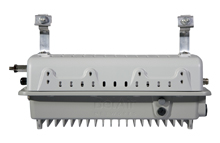BelAir Bows Combo 3G/Wi-Fi Product Aimed at Cable, Telcos

BelAir Networks, which makes wireless networking products used by cable
operators Cablevision, Comcast and Time Warner Cable and telco AT&T to
create Wi-Fi networks in major metropolitan markets like New York and Chicago,
has developed a new compact wireless base station that be used to deliver
mobile broadband Internet access via both licensed and unlicensed wireless spectrum.
The Ottawa,
Can.-based firm's new BelAir100SP Strand "Picocell" device is
designed to connect to hybrid fiber-coax networks through a DOCSIS 3.0 Modem
and includes both 3G and dual 802.11n (Wi-Fi) radios, allowing a cable operator
or telco to provide wireless broadband service using either technology in
congested, data-hungry urban markets. BelAir Networks is demonstrating the modular
device this week at the CableLabs Summer Conference Innovation Showcase in
Keystone, Colo.
While a "femtocell" is a wireless base station designed to
improve wireless coverage in inside a home, a picocell is aimed at busy urban
environments where heavy use is straining the capacity of existing networks,
explains BelAir VP of product marketing Dave Park. Picocells have an effective
range of 300-500 meters but are designed to be placed in closed proximity, either
mounted on utility poles, on the sides of buildings or underground, to boost
broadband connectivity. An urban train station might be equipped for wireless
access by installing two or three picocells.
The Wi-Fi networks that Cablevision, Comcast and Time Warner Cable have
set up in the greater New York City
market, which allow broadband subscribers of all three operators to pass
between their networks and enjoy Internet access on the go, are a good example
of how picocell technology can be effectively by cable operators. AT&T has
also deployed the technology in Chicago
to improve the user experience for 3G wireless customers. BelAir plans to also
support the LTE wireless standard in the future.
"A cable operator can function as a managed wireless service
provider with a hosted base station model," says Park. "It allows
them to sweat their existing assets for additional revenue or to improve
subscriber retention."
The BelAir100SP measures 10x10x16" and weighs 35 pounds, gets its
power from the HFC network and can be installed in about 10 minutes, says Park.
It will be priced competitively with other picocells on the market, which generally
fall in the $2,000-$5,000 range.
Given the steady growth in demand for broadband access, particularly in
large cities, research firm In-Stat predicts the worldwide metropolitan
picocell equipment market will be worth more than $5 billion by 2014.
Broadcasting & Cable Newsletter
The smarter way to stay on top of broadcasting and cable industry. Sign up below
